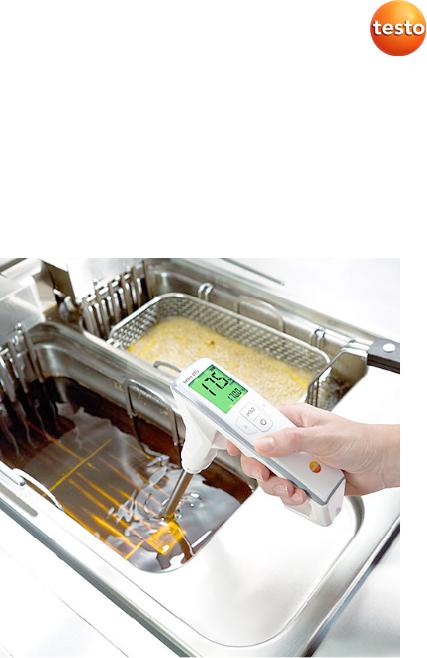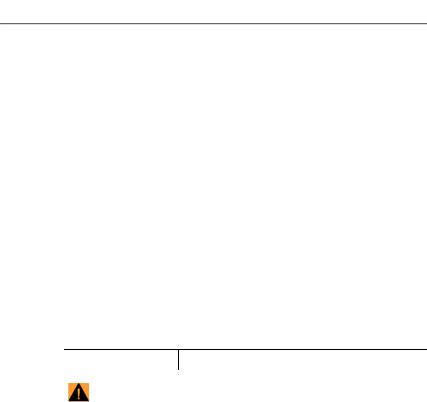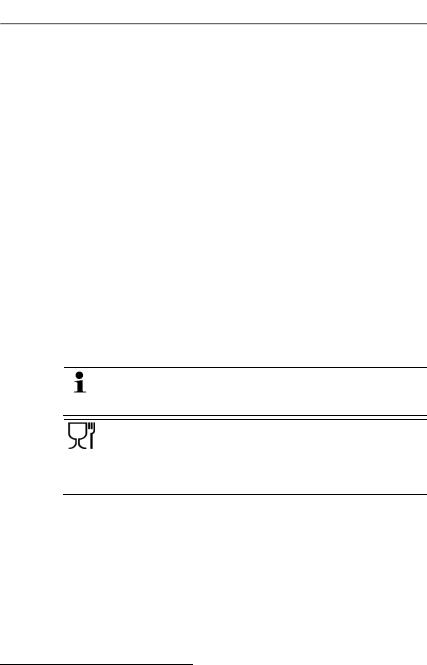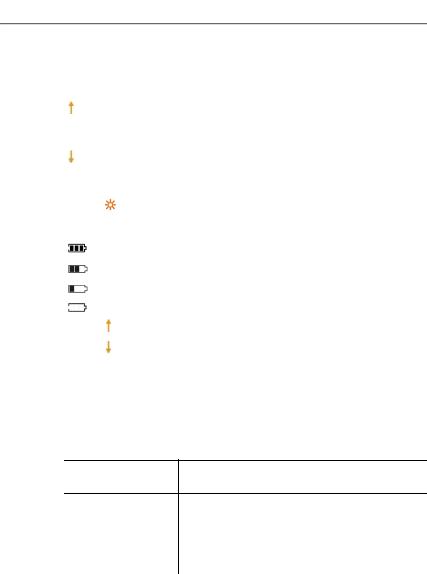Testo 270 Operating Manual

testo 270 · Deep-frying Oil Tester
Instruction manual

2

1 Contents
Pos: 1 /TD/Produktbeschreibung/Grundlegende Eigenschaften/testo 275/Inbetriebnahmehinweise Kalibrierung testo 275 @ 15\mod_1407391938938_79.docx @ 194097 @ @ 1
Practical tips before commissioning your new testo 270
Dear Customer,
Congratulations on purchasing your new testo 270 cooking oil tester.
All our measuring instruments are factory tested by us before delivery and adjusted to their own specific level of accuracy. To ensure a consistently high level of accuracy, we recommend the instrument is regularly checked.
You have the following options with the testo 270 cooking oil tester:
1Testo factory calibration according to ISO (accuracy +/- 2% TPM1):
You can order an ISO calibration from Testo's calibration subsidiary, Testo Industrial Services in Kirchzarten, using order number 0520 0028. This means your testo 270 will be calibrated at two points (at approx. 3% and at approx. 24% TPM) under precise laboratory conditions.
Furthermore, you have the following options for checking your testo 270 yourself at any time:
2with Testo reference oil (accuracy +/- 2.5% TPM1):
With the Testo reference oil (order no. 0554 2650), you can check the measuring instrument precisely and, if necessary, readjust it (please pay attention to the description in the instruction manual for this).
3with the simple function test in cooking oil (accuracy +/- 3% TPM1):
For a simple function test without adjustment, we recommend you carry out a measurement during the commissioning of your new instrument in unused cooking oil at 150 to 180 °C.
You should ideally carry out this measurement several times in succession and note the respective readings. The mean value of these readings represents your specific reference value for subsequent instrument checking. To use the determined reference value as a comparative value for a check, always carry out the measurement for instrument checking in unused cooking oil at 150 to 180 °C.
Please make sure that the reference value is recalculated if the type of oil or oil supplier changes.
Your specific reference value:
___________________________
1 typically, based on Testo in-house reference, at an ambient temperature of 25 °C.
3

1 Contents
Pos: 2 /TD/Überschriften/1. Inhalt @ 0\mod_1177587817070_79.docx @ 1243 @ 1 @ 1
1 Contents
1 |
Contents .................................................................................................. |
|
4 |
|
2 |
Safety and the environment ................................................................... |
5 |
||
|
2.1. |
About this document ....................................................................... |
5 |
|
|
2.2. |
Ensure safety .................................................................................. |
6 |
|
|
2.3. |
Protecting the environment ............................................................. |
7 |
|
3 |
Specifications.......................................................................................... |
|
8 |
|
|
3.1. |
Use ................................................................................................. |
|
8 |
|
3.2. |
Technical data................................................................................. |
8 |
|
4 |
Product description .............................................................................. |
10 |
||
|
4.1. |
Overview....................................................................................... |
|
10 |
|
4.2. |
Basic properties ............................................................................ |
12 |
|
5 |
First steps.............................................................................................. |
|
13 |
|
|
5.1. |
Commissioning ............................................................................. |
13 |
|
|
5.2. Getting to know the product .......................................................... |
15 |
||
|
|
5.2.1. Switching the instrument on/off...................................................................... |
15 |
|
|
|
5.2.2. Description of important functions and displays ............................................. |
16 |
|
|
|
5.2.2.1. |
Alarm indicator ................................................................................ |
16 |
|
|
5.2.2.2. Setting the TPM limit values ............................................................ |
16 |
|
|
|
5.2.2.3. |
Hold function ................................................................................... |
17 |
|
|
5.2.2.4. |
Auto-Hold function........................................................................... |
17 |
|
|
5.2.2.5. |
Auto-off function .............................................................................. |
17 |
|
|
5.2.2.6. |
Battery capacity............................................................................... |
18 |
|
|
5.2.3. Configuring the instrument............................................................................. |
18 |
|
|
|
5.2.4. Locking / unlocking configurations ................................................................. |
20 |
|
6 |
Using the product ................................................................................. |
|
22 |
|
|
6.1. |
General measurement information................................................ |
22 |
|
|
6.2. |
Carrying out measurements.......................................................... |
23 |
|
|
6.3. |
Function test ................................................................................. |
|
25 |
7 |
Maintaining the product ....................................................................... |
26 |
||
|
7.1. |
Changing batteries........................................................................ |
26 |
|
|
7.2. |
Cleaning the sensor ...................................................................... |
26 |
|
|
7.3. |
Cleaning the housing .................................................................... |
27 |
|
|
7.4. Cleaning the plastic case .............................................................. |
27 |
||
|
7.5. |
Calibrating/adjusting the instrument.............................................. |
28 |
|
8 |
Tips and assistance .............................................................................. |
32 |
||
|
8.1. |
Questions and answers ................................................................ |
32 |
|
|
8.2. |
Accessories and spare parts......................................................... |
33 |
|
4

2 Safety and the environment
Pos: 4 /TD/Überschriften/2. Sicherheit und Umwelt @ 0\mod_1173774719351_79.docx @ 292 @ 1 @ 1
2 Safety and the environment
2.1.About this document
Use
>Please read this documentation through carefully and familiarize yourself with the product before putting it to use. Pay particular attention to the safety instructions and warning advice in order to prevent injuries and damage to the products.
>Keep this document to hand so that you can refer to it when necessary.
>Hand this documentation on to any subsequent users of the product.
Warnings
Always pay attention to information that is marked by the following warnings with warning pictograms. Implement the specified precautionary measures.
Representation Explanation
|
WARNING |
Indicates potential serious injuries |
|
|
|
|
NOTICE |
indicates circumstances that may lead to |
|
damage to the products |
|
|
|
|
|
|
|
5

2 Safety and the environment
Symbols and writing standards
Represen- |
Explanation |
tation |
|
|
|
|
Note: Basic or further information. |
|
|
|
|
1. ... |
Action: more steps, the sequence must be followed. |
2. ... |
|
|
|
> ... |
Action: a step or an optional step. |
|
|
- ... |
Result of an action. |
|
|
Menu |
Elements of the instrument, the instrument displays |
|
or the program interface. |
|
|
[OK] |
Control keys of the instrument or buttons of the |
|
program interface. |
|
|
... | ... |
Functions/paths within a menu. |
|
|
“...” |
Example entries |
2.2.Ensure safety
>Only operate the product properly, for its intended purpose and within the parameters specified in the technical data. Do not use any force.
>Do not operate the instrument if there are signs of damage at the housing, mains unit or feed lines.
>The objects to be measured or the measurement environment may also pose risks: Note the safety regulations valid in your area when performing the measurements.
>Temperatures given on probes/sensors relate only to the measuring range of the sensors. Do not expose handles and feed lines to any temperatures in excess of 70 °C unless they are expressly permitted for higher temperatures.
>Do not perform contact measurements on non-insulated, live parts.
6

2 Safety and the environment
>Transport and store the instrument exclusively in the aluminium case provided in order to avoid damage to the sensor.
>Do not store the product together with solvents. Do not use any desiccants.
>Carry out only the maintenance and repair work on this instrument that is described in the documentation. Follow the prescribed steps exactly. Use only original spare parts from Testo.
2.3.Protecting the environment
>Dispose of faulty rechargeable batteries/spent batteries in accordance with the valid legal specifications.
>At the end of its useful life, send the product to the separate collection for electric and electronic devices (observe local regulations) or return the product to Testo for disposal.
7

3 Specifications
Pos: 28 /TD/Überschriften/3. Leistungsbeschreibung @ 0\mod_1173774791554_79.docx @ 301 @ 1 @ 1
3 Specifications
3.1.Use
The testo 270 is a handy measuring instrument for fast testing of cooking oils.
The TPM value (total polar materials) enables a statement on the ageing of cooking oils due to the effects of heat.
The following measuring tasks can be performed with the testo 270:
•Displaying the temperature of the cooking oil:
Indicator for correct setting of the deep fat fryer, checking of integrated temperature displays.
•Displaying the TPM value:
Indicator for the ageing of the cooking oil.
The sensor works on a capacitive basis and determines as the reading the total polar materials as a %.
The free fatty acids, which are determined above all for the evaluation of unloaded oils (rancidity), cannot be detected with the testo 270.
The temperature of the cooking oil to be measured must be at least 40 °C. The maximum operating temperature is
200 °C.
The sensor and the probe tube are designed to come into contact with oil used in deep fat fryers for the typical duration of a spot check measurement. The materials used in these components meet the relevant requirements in the Regulation (EC)1935/2004.
3.2.Technical data
Feature |
Values |
Measuring range |
Temperature: 40.0 to 200.0 °C / |
|
104.0 to 392.0°F |
|
TPM: 0 to 40% |
|
|
Accuracy |
Temperature: ± 1.5 °C |
|
TPM2: ±2% (40.0 to 190.0 °C / 104 to 374 °F) |
2 typically, based on Testo in-house reference, at an ambient temperature of 25 °C.
8

|
3 Specifications |
|
|
Feature |
Values |
Resolution |
Temperature: 0.1 °C / 0.1 °F |
|
TPM: 0.5% |
|
|
Power supply |
Batteries: 2x micro (type AAA) |
|
|
Battery (micro AAA) |
Designation according to IEC: LR03 |
|
Chem. composition: Zn-MnO2 (alkaline) |
|
|
Battery life at 20 °C |
Approx. 25 hrs continuous operation |
|
(corresponds to 500 measurements) without |
|
display illumination |
Temperature |
PTC |
sensor |
|
TPM sensor |
Capacitive sensor (Testo) |
|
|
Operating |
0 to 50 °C / 32 to 122 °F |
temperature |
|
Ambient humidity |
0 to 90%RH |
Storage/transport |
-20 to 70 °C / -4 to 158 °F |
temperature |
|
Display |
LCD, 2-line, display illumination |
Weight |
255 g |
Housing material |
Top part: ABS |
|
Lower part: ABS-PC glass fibre 10% |
Dimensions |
Approx. 50 mm x 170 mm x 300 mm |
|
(WxHxD) |
TPM response time |
Approx. 30 secs |
Protection class |
IP65 |
Warranty |
24 months |
|
|
EC Directive |
2014/30/EC |
|
|
9

4 Product description
Pos: 34 /TD/Überschriften/4. Produktbeschreibung @ 0\mod_1173774846679_79.docx @ 310 @ 1 @ 1
4 Product description
4.1.Overview
1Display
2Control keys
3Battery compartment
4Probe shaft
5Oil quality (%TPM) and temperature sensor
6Min. immersion depth
7Max. immersion depth
10

4 Product description
Pos: 37 /TD/Produktbeschreibung/Übersicht/testo 275/Display (testo 275) @ 15\mod_1407397717503_79.docx @ 194238 @ 5 @ 1
Items shown on the display:
Items shown |
Function/property |
200 (flashing |
Temperature measuring range exceeded |
temperature value |
|
> 200 °C) |
|
40 (flashing |
Temperature measuring range undershot |
temperature value |
|
< 40 °C) |
|
Alarm |
Alarm indicator activated |
PIN |
Configuration mode locked |
|
Battery capacity 100 % |
|
|
|
Battery capacity 66 % |
|
Battery capacity 33 % |
|
Battery capacity < 10 % |
Alarm |
Upper TPM limit value exceeded |
Alarm |
Lower TPM limit value exceeded |
Hold |
Readings held (manually) |
Auto-Hold |
Readings held (automatically) |
°C / °F |
Temperature in °C or °F |
Important display messages
Item shown on the Explanation display
000 lights up |
Instrument is ready to measure, sensor is not |
|
in oil. |
Reading >190 |
Measured temperature is above 190 °C |
flashes |
(374 °F). The reading flashes in the range |
|
from 190.1 °C (374 °F) to 200 °C (392 °F). |
11
